brake light SATURN VUE HYBRID 2007 Owners Manual
[x] Cancel search | Manufacturer: SATURN, Model Year: 2007, Model line: VUE HYBRID, Model: SATURN VUE HYBRID 2007Pages: 438, PDF Size: 2.83 MB
Page 115 of 438
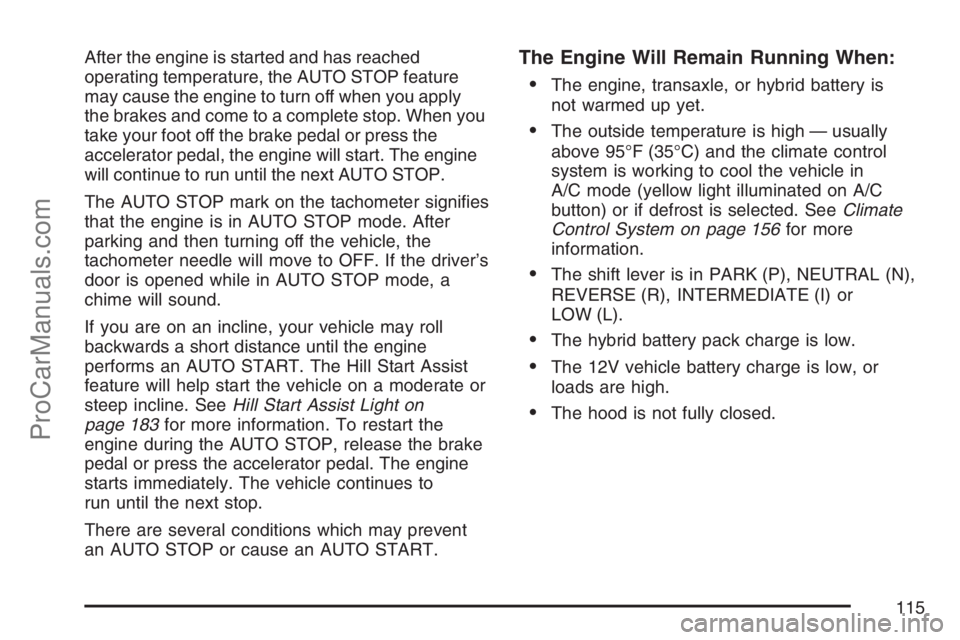
After the engine is started and has reached
operating temperature, the AUTO STOP feature
may cause the engine to turn off when you apply
the brakes and come to a complete stop. When you
take your foot off the brake pedal or press the
accelerator pedal, the engine will start. The engine
will continue to run until the next AUTO STOP.
The AUTO STOP mark on the tachometer signi�es
that the engine is in AUTO STOP mode. After
parking and then turning off the vehicle, the
tachometer needle will move to OFF. If the driver’s
door is opened while in AUTO STOP mode, a
chime will sound.
If you are on an incline, your vehicle may roll
backwards a short distance until the engine
performs an AUTO START. The Hill Start Assist
feature will help start the vehicle on a moderate or
steep incline. SeeHill Start Assist Light on
page 183for more information. To restart the
engine during the AUTO STOP, release the brake
pedal or press the accelerator pedal. The engine
starts immediately. The vehicle continues to
run until the next stop.
There are several conditions which may prevent
an AUTO STOP or cause an AUTO START.The Engine Will Remain Running When:
The engine, transaxle, or hybrid battery is
not warmed up yet.
The outside temperature is high — usually
above 95°F (35°C) and the climate control
system is working to cool the vehicle in
A/C mode (yellow light illuminated on A/C
button) or if defrost is selected. SeeClimate
Control System on page 156for more
information.
The shift lever is in PARK (P), NEUTRAL (N),
REVERSE (R), INTERMEDIATE (I) or
LOW (L).
The hybrid battery pack charge is low.
The 12V vehicle battery charge is low, or
loads are high.
The hood is not fully closed.
115
ProCarManuals.com
Page 116 of 438
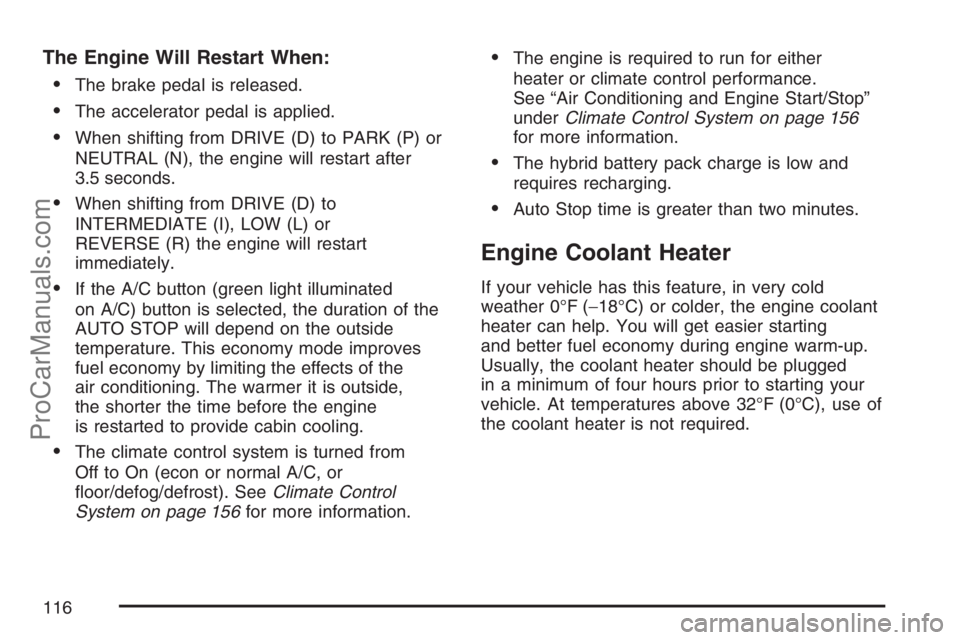
The Engine Will Restart When:
The brake pedal is released.
The accelerator pedal is applied.
When shifting from DRIVE (D) to PARK (P) or
NEUTRAL (N), the engine will restart after
3.5 seconds.
When shifting from DRIVE (D) to
INTERMEDIATE (I), LOW (L) or
REVERSE (R) the engine will restart
immediately.
If the A/C button (green light illuminated
on A/C) button is selected, the duration of the
AUTO STOP will depend on the outside
temperature. This economy mode improves
fuel economy by limiting the effects of the
air conditioning. The warmer it is outside,
the shorter the time before the engine
is restarted to provide cabin cooling.
The climate control system is turned from
Off to On (econ or normal A/C, or
�oor/defog/defrost). SeeClimate Control
System on page 156for more information.
The engine is required to run for either
heater or climate control performance.
See “Air Conditioning and Engine Start/Stop”
underClimate Control System on page 156
for more information.
The hybrid battery pack charge is low and
requires recharging.
Auto Stop time is greater than two minutes.
Engine Coolant Heater
If your vehicle has this feature, in very cold
weather 0°F (−18°C) or colder, the engine coolant
heater can help. You will get easier starting
and better fuel economy during engine warm-up.
Usually, the coolant heater should be plugged
in a minimum of four hours prior to starting your
vehicle. At temperatures above 32°F (0°C), use of
the coolant heater is not required.
116
ProCarManuals.com
Page 120 of 438
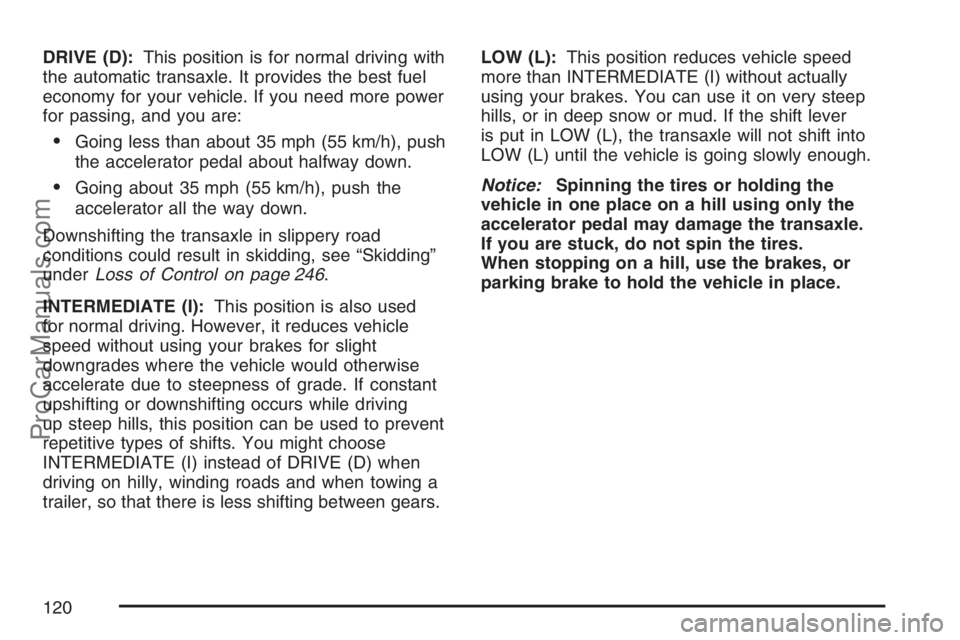
DRIVE (D):This position is for normal driving with
the automatic transaxle. It provides the best fuel
economy for your vehicle. If you need more power
for passing, and you are:
Going less than about 35 mph (55 km/h), push
the accelerator pedal about halfway down.
Going about 35 mph (55 km/h), push the
accelerator all the way down.
Downshifting the transaxle in slippery road
conditions could result in skidding, see “Skidding”
underLoss of Control on page 246.
INTERMEDIATE (I):This position is also used
for normal driving. However, it reduces vehicle
speed without using your brakes for slight
downgrades where the vehicle would otherwise
accelerate due to steepness of grade. If constant
upshifting or downshifting occurs while driving
up steep hills, this position can be used to prevent
repetitive types of shifts. You might choose
INTERMEDIATE (I) instead of DRIVE (D) when
driving on hilly, winding roads and when towing a
trailer, so that there is less shifting between gears.LOW (L):This position reduces vehicle speed
more than INTERMEDIATE (I) without actually
using your brakes. You can use it on very steep
hills, or in deep snow or mud. If the shift lever
is put in LOW (L), the transaxle will not shift into
LOW (L) until the vehicle is going slowly enough.
Notice:Spinning the tires or holding the
vehicle in one place on a hill using only the
accelerator pedal may damage the transaxle.
If you are stuck, do not spin the tires.
When stopping on a hill, use the brakes, or
parking brake to hold the vehicle in place.
120
ProCarManuals.com
Page 121 of 438

Parking Brake
The parking brake lever is located to the right of
the driver’s seat.
To set the parking brake, hold the brake pedal
down and pull up on the parking brake lever. If the
ignition is on, the brake system warning light will
come on.
To release the parking brake, hold the brake pedal
down. Pull the parking brake lever up until you can
press the release button. Hold the release button in
as you move the brake lever all the way down.Make sure to release the parking brake before
driving the vehicle.
Notice:Driving with the parking brake on
can overheat the brake system and cause
premature wear or damage to brake system
parts. Verify that the parking brake is fully
released and the brake warning light is
off before driving.
Regenerative Braking
Your vehicle has a regenerative braking system.
Regenerative braking takes some of the energy
from the moving vehicle and turns it back
into electrical energy. This energy is then stored
back into the vehicle’s hybrid battery system,
contributing to increased fuel efficiency.
The system works whenever you take your foot
off the accelerator pedal while your vehicle is
moving in DRIVE (D), INTERMEDIATE (I) or,
LOW (L) gear. This causes your vehicle to slow
down slightly faster. It may feel like the brake
pedal is being pressed, even when it is not.
121
ProCarManuals.com
Page 139 of 438
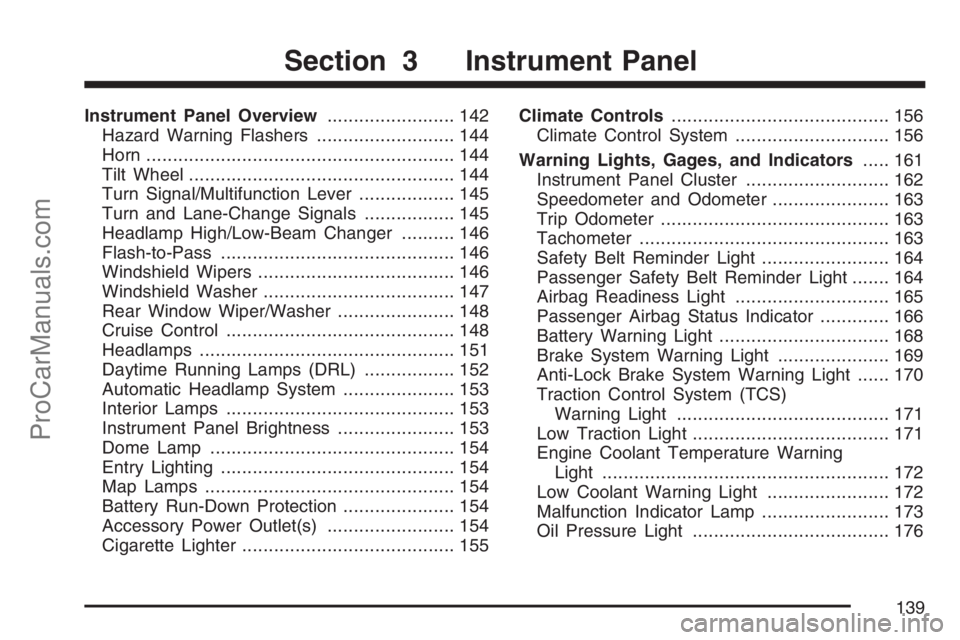
Instrument Panel Overview........................ 142
Hazard Warning Flashers.......................... 144
Horn.......................................................... 144
Tilt Wheel.................................................. 144
Turn Signal/Multifunction Lever.................. 145
Turn and Lane-Change Signals................. 145
Headlamp High/Low-Beam Changer.......... 146
Flash-to-Pass............................................ 146
Windshield Wipers..................................... 146
Windshield Washer.................................... 147
Rear Window Wiper/Washer...................... 148
Cruise Control........................................... 148
Headlamps................................................ 151
Daytime Running Lamps (DRL)................. 152
Automatic Headlamp System..................... 153
Interior Lamps........................................... 153
Instrument Panel Brightness...................... 153
Dome Lamp.............................................. 154
Entry Lighting............................................ 154
Map Lamps............................................... 154
Battery Run-Down Protection..................... 154
Accessory Power Outlet(s)........................ 154
Cigarette Lighter........................................ 155Climate Controls......................................... 156
Climate Control System............................. 156
Warning Lights, Gages, and Indicators..... 161
Instrument Panel Cluster........................... 162
Speedometer and Odometer...................... 163
Trip Odometer........................................... 163
Tachometer............................................... 163
Safety Belt Reminder Light........................ 164
Passenger Safety Belt Reminder Light....... 164
Airbag Readiness Light............................. 165
Passenger Airbag Status Indicator............. 166
Battery Warning Light................................ 168
Brake System Warning Light..................... 169
Anti-Lock Brake System Warning Light...... 170
Traction Control System (TCS)
Warning Light........................................ 171
Low Traction Light..................................... 171
Engine Coolant Temperature Warning
Light...................................................... 172
Low Coolant Warning Light....................... 172
Malfunction Indicator Lamp........................ 173
Oil Pressure Light..................................... 176
Section 3 Instrument Panel
139
ProCarManuals.com
Page 149 of 438
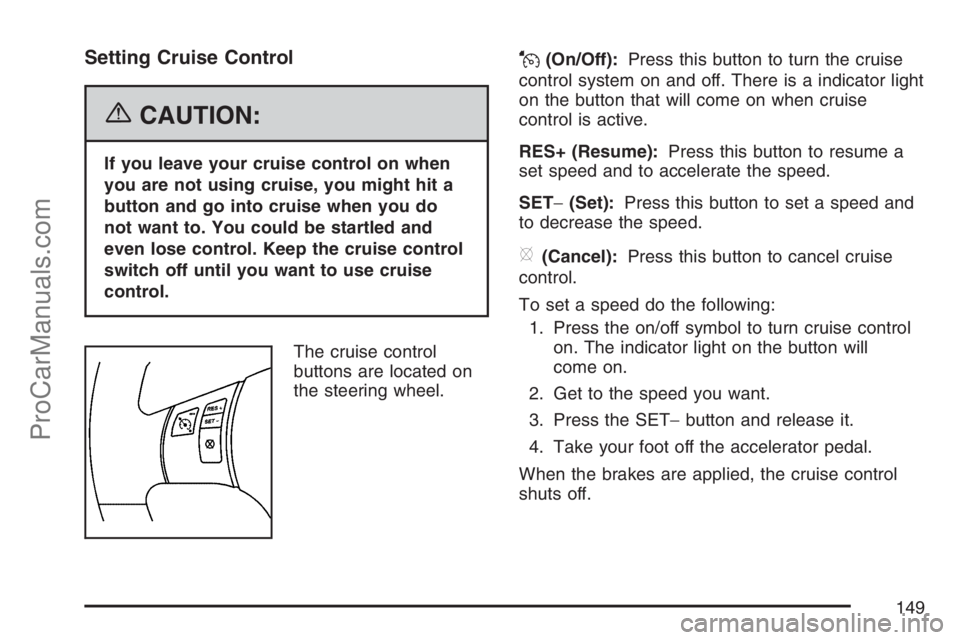
Setting Cruise Control
{CAUTION:
If you leave your cruise control on when
you are not using cruise, you might hit a
button and go into cruise when you do
not want to. You could be startled and
even lose control. Keep the cruise control
switch off until you want to use cruise
control.
The cruise control
buttons are located on
the steering wheel.
J(On/Off):Press this button to turn the cruise
control system on and off. There is a indicator light
on the button that will come on when cruise
control is active.
RES+ (Resume):Press this button to resume a
set speed and to accelerate the speed.
SET−(Set):Press this button to set a speed and
to decrease the speed.
[(Cancel):Press this button to cancel cruise
control.
To set a speed do the following:
1. Press the on/off symbol to turn cruise control
on. The indicator light on the button will
come on.
2. Get to the speed you want.
3. Press the SET−button and release it.
4. Take your foot off the accelerator pedal.
When the brakes are applied, the cruise control
shuts off.
149
ProCarManuals.com
Page 150 of 438
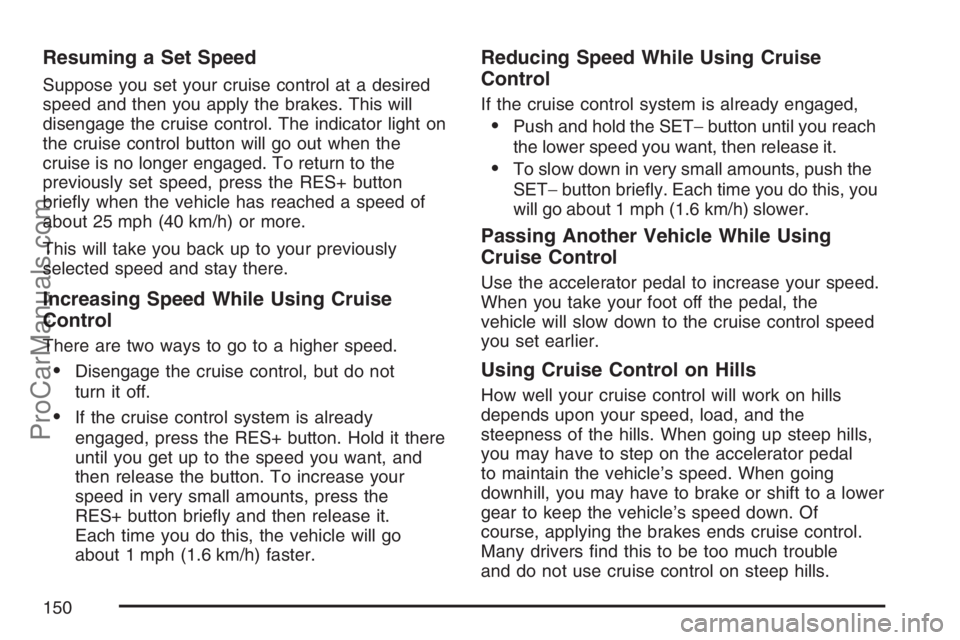
Resuming a Set Speed
Suppose you set your cruise control at a desired
speed and then you apply the brakes. This will
disengage the cruise control. The indicator light on
the cruise control button will go out when the
cruise is no longer engaged. To return to the
previously set speed, press the RES+ button
brie�y when the vehicle has reached a speed of
about 25 mph (40 km/h) or more.
This will take you back up to your previously
selected speed and stay there.
Increasing Speed While Using Cruise
Control
There are two ways to go to a higher speed.
Disengage the cruise control, but do not
turn it off.
If the cruise control system is already
engaged, press the RES+ button. Hold it there
until you get up to the speed you want, and
then release the button. To increase your
speed in very small amounts, press the
RES+ button brie�y and then release it.
Each time you do this, the vehicle will go
about 1 mph (1.6 km/h) faster.
Reducing Speed While Using Cruise
Control
If the cruise control system is already engaged,
Push and hold the SET−button until you reach
the lower speed you want, then release it.
To slow down in very small amounts, push the
SET−button brie�y. Each time you do this, you
will go about 1 mph (1.6 km/h) slower.
Passing Another Vehicle While Using
Cruise Control
Use the accelerator pedal to increase your speed.
When you take your foot off the pedal, the
vehicle will slow down to the cruise control speed
you set earlier.
Using Cruise Control on Hills
How well your cruise control will work on hills
depends upon your speed, load, and the
steepness of the hills. When going up steep hills,
you may have to step on the accelerator pedal
to maintain the vehicle’s speed. When going
downhill, you may have to brake or shift to a lower
gear to keep the vehicle’s speed down. Of
course, applying the brakes ends cruise control.
Many drivers �nd this to be too much trouble
and do not use cruise control on steep hills.
150
ProCarManuals.com
Page 151 of 438

Ending Cruise Control
There are three ways to disengage the cruise
control:
Step lightly on the brake pedal or clutch; when
cruise control disengages, the indicator light
on the cruise control button will go out.
Press the on/off button, this will turn off the
cruise control system.
Press the cancel button.
Erasing Speed Memory
When you turn off the cruise control or the
ignition, your cruise control set speed memory
is erased.
Headlamps
The exterior lamp control is located on the turn
signal/multifunction lever.
O(Exterior Lamp Control):Turn the control
with this symbol on it to operate the exterior lamps.The exterior lamp control has the following three
positions:
AUTO (Automatic):Turn the control to this
position to put the headlamps in automatic mode.
AUTO mode will turn the exterior lamps on
and off depending upon how much light is
available outside of the vehicle.
;(Parking Lamps):Turn the control to this
position to turn on the parking lamps together with
the following:
Sidemarker Lamps
Taillamps
License Plate Lamps
Instrument Panel Lights
53(Headlamps):Turning the control to this
position turns on the headlamps, together with the
previously listed lamps and lights.
Lamps On Reminder
If you open the driver’s door with the ignition off
and the lamps on, you will hear a warning chime.
151
ProCarManuals.com
Page 152 of 438

Daytime Running Lamps (DRL)
Daytime Running Lamps (DRL) can make it easier
for others to see the front of your vehicle during
the day. DRL can be helpful in many different
driving conditions, but they can be especially
helpful in the short periods after dawn and before
sunset. Fully functional daytime running lamps
are required on all vehicles �rst sold in Canada.
The DRL system will make your low-beam
headlamps come on at a reduced brightness in
daylight when the following conditions are met:
The ignition is on,
the exterior lamp band is in AUTO,
the transaxle is not in PARK (P),
the light sensor determines it is daytime, and
the parking brake is released.When the DRL are on, the low-beam headlamps
will be on at a reduced brightness. The taillamps,
sidemarker and other lamps will not be on.
The instrument panel will not be lit up either.
When you turn the exterior lamp band to
the headlamp position, your regular headlamps
will come on. The other lamps that come on with
your headlamps will also come on.
When you turn off the headlamps, the regular
lamps will go off, and your low-beam headlamps
will come on to the reduced brightness.
To idle your vehicle with the DRL off, move the
shift lever to PARK (P). The DRL will stay off
until you move the shift lever out of PARK (P).
To override the DRL on manual transaxle vehicles,
you must set the parking brake while the ignition
is off and then start your vehicle. The DRL will stay
off until you release the parking brake.
As with any vehicle, you should turn on the
regular headlamp system when you need it.
152
ProCarManuals.com
Page 169 of 438
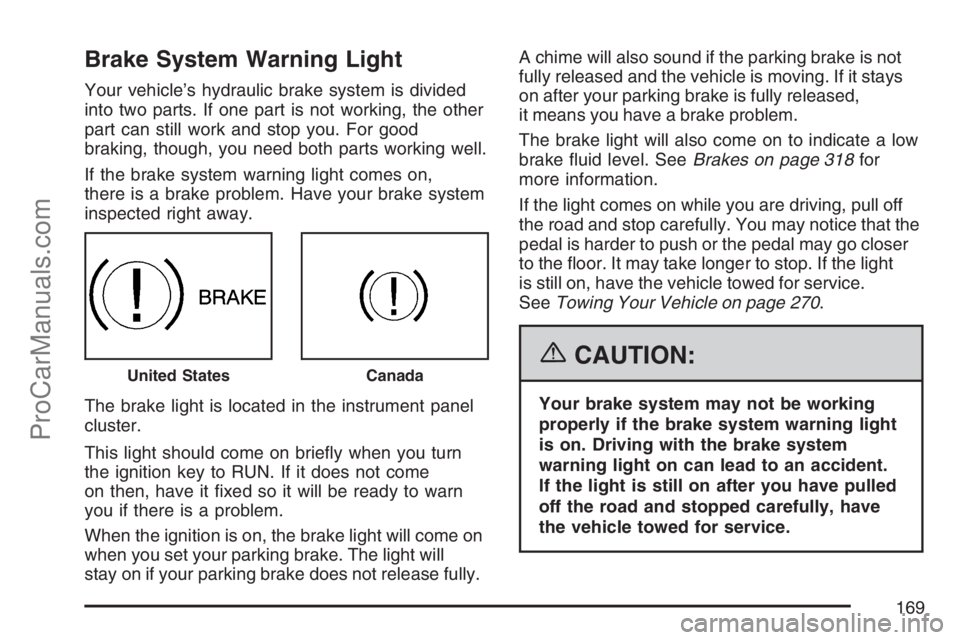
Brake System Warning Light
Your vehicle’s hydraulic brake system is divided
into two parts. If one part is not working, the other
part can still work and stop you. For good
braking, though, you need both parts working well.
If the brake system warning light comes on,
there is a brake problem. Have your brake system
inspected right away.
The brake light is located in the instrument panel
cluster.
This light should come on brie�y when you turn
the ignition key to RUN. If it does not come
on then, have it �xed so it will be ready to warn
you if there is a problem.
When the ignition is on, the brake light will come on
when you set your parking brake. The light will
stay on if your parking brake does not release fully.A chime will also sound if the parking brake is not
fully released and the vehicle is moving. If it stays
on after your parking brake is fully released,
it means you have a brake problem.
The brake light will also come on to indicate a low
brake �uid level. SeeBrakes on page 318for
more information.
If the light comes on while you are driving, pull off
the road and stop carefully. You may notice that the
pedal is harder to push or the pedal may go closer
to the �oor. It may take longer to stop. If the light
is still on, have the vehicle towed for service.
SeeTowing Your Vehicle on page 270.
{CAUTION:
Your brake system may not be working
properly if the brake system warning light
is on. Driving with the brake system
warning light on can lead to an accident.
If the light is still on after you have pulled
off the road and stopped carefully, have
the vehicle towed for service.
United StatesCanada
169
ProCarManuals.com